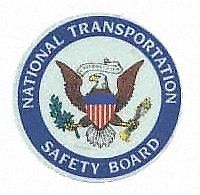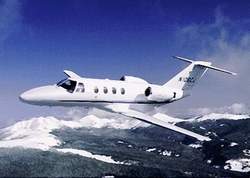Recommends Aural Warning, Contrasting Color Bands On
Indicator
 In response to a July 2003 accident, on
Thursday the National Transportation Safety Board issued three
recommendations to the Federal Aviation Administration, addressing
the Board's concerns with runway trim on Cessna Citation 525 model
aircraft.
In response to a July 2003 accident, on
Thursday the National Transportation Safety Board issued three
recommendations to the Federal Aviation Administration, addressing
the Board's concerns with runway trim on Cessna Citation 525 model
aircraft.
"On July 22, 2003, about 1015 Pacific daylight time, a Cessna
Citation 525, N996JR, was ditched in the waters of Penn Cove,
Coupeville, Washington, following a loss of elevator trim control
that resulted in an uncommanded nose-down pitch attitude," the NTSB
writes. "... According to the pilot’s postaccident statement,
he configured the airplane’s autopilot for a climb to flight
level 330, (33,000 feet) at an indicated airspeed of 200 knots, and
a climb power setting shortly after departing Victoria
International Airport about 0950.
"However, after climbing through 14,000 feet mean sea level, the
pilot noticed a decrease in the airplane’s rate of climb. In
response, he pressed the autopilot/trim disengage switch on the
control yoke, which disconnected the autopilot. The pilot indicated
that the airplane’s nose immediately pitched down to an
attitude approximately 10º below the horizon and that "within
seconds it was apparent that level flight was not possible" as he
pulled back on the control yoke."
The NTSB adds the pilot took several measures to counteract the
problem, then noticed the elevator trim indicator was in fill
nose-down position. Despite efforts by both the pilot and
passenger, seated in the copilot's seat, to hold the yoke back and
attempt to move the trim wheel, it was apparent level flight could
not be maintained.
"Despite the nose-down force on the control column, the pilot
was able to maneuver the airplane to the vicinity of Whidbey
Island, Washington, and attempted to land the airplane at a nearby
airport," the NTSB says. "After reaching the island, however, the
pilot determined he could not safely land the airplane on a runway
and elected to land on the water at Penn Cove. He indicated that he
extended the flaps to a landing position and, with the landing gear
retracted, ditched the airplane into the water, coming to rest
approximately 300 yards from shore."
Postaccident examination of the pitch control system found the
autopilot trim down (K6) relay failed in the closed, or power on,
position, according to the NTSB... resulting in power being
continuously applied to the trim motor.
 In such a condition,
the autopilot/trim disconnect switch -- which the pilot did press
-- would not have cured the problem; the only way to stop the motor
from operating would have been to pull the pitch trim circuit
breaker -- one of over 60 identical breaker switches on the
panel.
In such a condition,
the autopilot/trim disconnect switch -- which the pilot did press
-- would not have cured the problem; the only way to stop the motor
from operating would have been to pull the pitch trim circuit
breaker -- one of over 60 identical breaker switches on the
panel.
The NTSB notes Cessna has since corrected the relay problem, in
response to an FAA Airworthiness Directive; furthermore, all
Citation 525s come with an "AP OUT OF TRIM" warning light above the
altimeter to alert the pilot to such a runaway trim condition.
However, the Board believes an aural indicator is also called
for, as well as other measures outlined below... to better
call the pilot's attention to a potentially hazardous
situation, and make it easier for them to take corrective
action:
- Require Cessna to modify the Citation 525 to incorporate an
aural trim-in-motion warning and the addition of contrasting color
bands on the pitch trim wheel to provide the pilot with more timely
recognition of a trim runaway condition before control forces
become unmanageable. (A-07-52)
- Require Cessna to perform analysis and conduct a test to
demonstrate that the maximum control forces in a Cessna Citation
525 meet the certification requirements of 14 Code of Federal
Regulations Part 23 during a pitch trim runaway condition. The
analysis and test should comply with the pilot-recognition time
requirements provided in Advisory Circular 23-8, "Flight Test Guide
for Certification of Part 23 Airplanes." If, after accomplishing
the analysis and test, Cessna is unable to demonstrate that the
Citation 525 meets the certification requirements, require Cessna
to take corrective action so that the airplane does meet
certification requirements. (A-07-53)
- Require Cessna to replace the pitch trim circuit breaker on the
Citation 525 with a collared circuit breaker to aid the pilot in
quickly identifying it if necessary. (A-07-54)
 Aero-News: Quote of the Day (07.11.25)
Aero-News: Quote of the Day (07.11.25) ANN's Daily Aero-Term (07.11.25): Permanent Echo
ANN's Daily Aero-Term (07.11.25): Permanent Echo ANN's Daily Aero-Linx (07.11.25)
ANN's Daily Aero-Linx (07.11.25) NTSB Final Report: Schweizer SGS 2-33A
NTSB Final Report: Schweizer SGS 2-33A NTSB Prelim: Aeronca 7AC
NTSB Prelim: Aeronca 7AC




